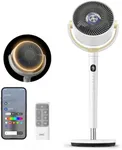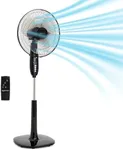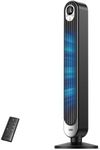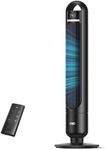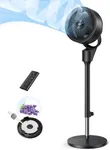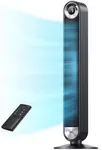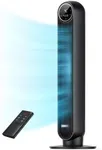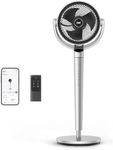Buying Guide for the Best Oscillating Fans
When you're looking to buy an oscillating fan, the main goal is to find a model that keeps your space comfortable and cool while being easy to use and fitting your needs. Oscillating fans move air by rotating back and forth, helping to distribute cool air evenly throughout a room, rather than just blowing it in one direction. It's important to consider where you will use the fan, how much noise you can tolerate, how much space you have, and how much airflow you need. Here are the key features and specs you should know about before choosing the right oscillating fan for you.Fan Size and TypeThe size and type of the oscillating fan determine how much space it can cover and where it can be placed. Sizes usually range from small desk fans to large pedestal or tower fans. Smaller fans are great for personal use in tight spaces, like on a desk or bedside table, whereas larger tower or pedestal fans can circulate air throughout an entire room. The right size depends on how much airflow you need and how much room you have for the fan; always consider where you will be using the fan when making your choice.
Oscillation AngleThe oscillation angle refers to how wide the fan can sweep left and right to cover more of the room. A narrow oscillation angle covers a smaller area, which might be fine for personal use, while a wide angle helps distribute air across a larger space. If you have a bigger room or want the air to reach multiple areas, look for a fan with a wider oscillation angle. If your space is smaller or you only need airflow in one direction, a narrower angle will suffice.
Airflow Speed SettingsFans typically come with multiple speed settings so you can adjust the amount of airflow. The number of speed options lets you control comfort and noise levels—fewer settings can be simpler, but more settings allow for finer control. If you need to use the fan in different situations, such as at night or in a hot afternoon, having several speed options lets you tailor the airflow to your needs. Choose a fan with speed settings that offer enough range for your comfort preferences.
Noise LevelNoise level is an important consideration, especially if you plan to use the fan in a bedroom, office, or any quiet environment. Some fans are designed to run quietly, while others can be quite loud on higher settings. If you're sensitive to noise or need to concentrate or sleep while the fan is running, look for fans that are marketed as quiet or have lower decibel ratings. If noise isn’t a big concern, you might have more flexibility in your options.
Control OptionsOscillating fans may offer basic manual switches, digital panels, or even remote controls. Simpler controls are often found on basic fans, while remote controls or digital timers provide more convenience, especially if you want to adjust settings from across the room. Think about how convenient you want your fan to be: if you don't mind getting up to adjust the fan, basic controls are fine; for added comfort and ease, a remote or smart controls might be better for you.
Height and Tilt AdjustmentAdjustable fans let you change the height and direction of airflow, giving you more control over where the breeze goes. Fixed fans work fine if you always want the air to hit the same spot, but if you sometimes want it higher or lower, or to reach different parts of the room, a fan with adjustable height and tilt will be more versatile. Consider how your needs might change from day to day or as you move the fan to different places.
Safety FeaturesSafety is especially important if you have children or pets at home. Features like sturdy bases, tightly spaced grilles, tilt-over protection, or child locks make a fan much safer to use in busy or family environments. If safety is a top concern, look for these features to prevent accidents or injuries.
Energy EfficiencyAn energy-efficient oscillating fan will use less electricity to run, which is both good for your utility bill and the environment. This is particularly important if you plan to run your fan for long periods. Look for fans that mention energy-saving features or have energy certifications, especially if you’re conscious about power usage.
